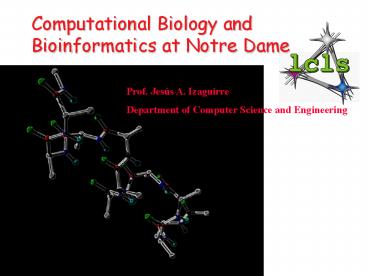Computational Biology and Bioinformatics at Notre Dame - PowerPoint PPT Presentation
1 / 14
Title:
Computational Biology and Bioinformatics at Notre Dame
Description:
Collaboration with Univ. of Maryland radiologists. Current Research at ND CSE II ... NSF Biocomplexity grant to model chicken limb development ... – PowerPoint PPT presentation
Number of Views:37
Avg rating:3.0/5.0
Title: Computational Biology and Bioinformatics at Notre Dame
1
Computational Biology and Bioinformatics at Notre
Dame
Prof. Jesús A. Izaguirre Department of Computer
Science and Engineering
2
Overview
- Systems approach to computational biology and
bioinformatics - Integrate multiple levels of information
- Distinguish noise from signal analysis of large
data sets - Mathematical modeling of biological complexity
- Computer assisted analysis of integrated data
- Research in CSE
- Biomedical engineering
- Biocomplexity simulations
- Computational biology and biochemistry
- Challenges
- Right biological problem and team
- Obstacles to interdisciplinary research
(publications, learning curve) - Computational resources
- Opportunities
- Indiana Biocomplexity Consortium
- Interdisciplinary Center for the Study of
Biocomplexity - Collaborative frameworks
- Systems biology approach
- Approximate multi-scale, multi-level models
3
Background on computational biology and
bioinformatics I
- How to integrate data from many levels?
- Genomic sequencing data
- Proteomics data (global analysis of proteins)
- Gene expression data (DNA microarrays)
- Protein-protein, metabolic networks
- Genetic regulatory networks
- Morphogenesis cellular and genetic
4
Background on computational biology and
bioinformatics II
- How to distinguish noise from signal?
- Growth in number of base pair sequences has
surpassed Moores law about the number of
transistors in a chip - Dr. Leroy Hood predicts that in 10 years, using
nanotechnology to analyze single cells and
molecules, one will sequence human genome in 1 day
5
Background on computational biology and
bioinformatics III
- Mathematical modeling of biological complexity
- Multiscale in nature
- Several qualitative models
- Rule based intuitive for biologist
- Continuum based PDE can be linked to
quantitative experiments - Discrete Monte Carlo or Molecular Dynamics
- Need to relate more to digital code
6
Background on computational biology and
bioinformatics IV
- Computer assisted analysis and visualization of
integrated data - Multi-tool in nature
- Geographically distributed, collection of
cooperating tools - Visualization and analysis should integrate both
simulation and experimental data, to facilitate
cross validation and comparisons - Dissemination via web services
7
Current Research at ND CSE I
- Danny Chen and students are developing algorithms
for radiosurgery treatment planning - Find a set of beams to destroy a tumor without
harming surrounding healthy tissues. - ConsiderationsDesired dose
- Constraints of the device delivering the
radiationTreatment time - Collaboration with Univ. of Maryland radiologists
8
Current Research at ND CSE II
- Greg Madey and Patricia Maurice (CE) are
developing a collaboratory for biocomplexity
simulation of environmental chemistry - Try to model the life cycle of pollutants in a
soil swamp ecosystem - Validated through experiments
- Web based interface using Java and SWARM
simulation package - Simulation results are stored in an Oracle
database (E-science) - Multi-institutional collaboration funded
through NSF Biocomplexity grant
9
Research in Izaguirres group I
- Jesús Izaguirre and collaborators are working on
- Computer-aided drug design, human genome
proteomics, and understanding of morphogenesis
by - Enabling simulations of biomolecules (Proteins,
DNA, etc.) - Permitting simulations of cells and organ growth
- CHALLENGES
- Large systems--millions of particles
- Long time scales--billions of time steps
- weeks and months of simulations in
supercomputers with hundreds of nodes!
10
Research in Izaguirres group II
- We have released CompuCell, a multi-model
software for simulation of morphogenesis - Models interaction of genetic regulatory system
with cellular dynamics - Uses knowledge-base, stochastic, discrete and
continuum model - NSF Biocomplexity grant to model chicken limb
development
11
Research in Izaguirres group III
- Molecular dynamics of biological molecules
- Faster algorithms, up to an order of magnitude
faster for molecular dynamics and sampling of
conformational space of proteins - Parallel program ProtoMol, a software framework
for molecular dynamics and related-applications,
which is open source (http//www.nd.edu/lcls/prot
omol)
- IN PROGRESS
- MULTISCALE approximate methods in biology and
MEMS (with Paolucci) - Applications in real problems
- Brian Baker in Chemistry (immune system)
- Ruhong Zhou at IBM T. J. Watson (BLUE GENE
project) - Grant application to NSF Nanoscale. Army in
preparation
12
Opportunities IIndiana Biocomplexity Consortium
Simulation Request
Results via XML
CompuCell Biocomplexity Computing Environment
Server
- OBJECTIVE Make ProtoMol and CompuCell into web
services - Web service for molecular and cellular
simulations - Component that provides data and simulation
capabilities through the web - NIH Center of Excellence proposal (Indiana
University and Notre Dame)
- APPROACH
- Integrated tools for simulation, visualization
and analysis - Use distributed grids
- Disseminate using web services
13
Opportunities IIResearch areas of interest
- Collaboratory frameworks recommender systems,
assistants, not just algorithms - Data mining in high performance environment
clustering, pattern recognition, distributed
databases - Modeling constrained optimization, stochastic
techniques, geometry - Simulation qualitative/quantitative models
14
References
- I would like to thank the following--
- NSF Biocomplexity grant IBN-0083653
- NSF CAREER award ACI-0135195
- Department of Computer Science and Engineering,
- Univ. of Notre Dame
- http//conferences.computer.org/bioinformatics
- http//smi-web.stanford.edu/people/altman
- http//geneticcircuits.ucsd.edu
- http//www.systemsbiology.org
- http//www.geneontology.org
- http//www.cytoscape.org
- http//www.genomatica.com
- http//www.nd.edu/lcls/compucell
- http//www.nd.edu/lcls/protomol
- http//www.nd.edu/xwu/uiowa_files/v3_document.htm































